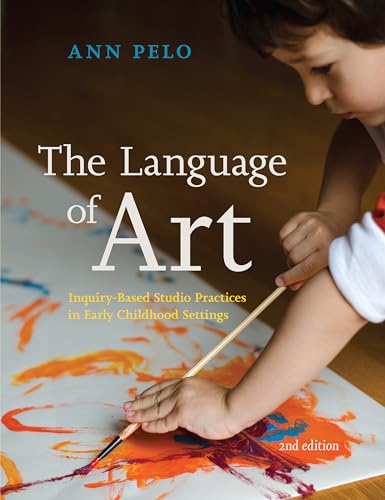Items related to The Language of Art: Inquiry-Based Studio Practices...

Synopsis
Typical art resources for teachers offer discrete art activities, but these don't carry children or teachers into the practice of using the languages of art. This resource offers guidance for teachers to create space, time, and intentional processes for children's exploration and learning to use art for asking questions, offering insights, exploring hypotheses, and examining experiences from unfamiliar perspectives.
Inspired by an approach to teaching and learning born in Reggio Emilia, Italy, The Language of Art, Second Edition, includes:
- A new art exploration for teachers to gain experience before implementing the practice with children
- Advice on setting up a studio space for art and inquiry
- Suggestions on documenting children's developing fluency with art media and its use in inquiry
- Inspiring photographs and ideas to show you how inquiry-based practices can work in any early childhood setting
Ann Pelo is a teacher educator, program consultant, and author whose primary work focuses on reflective pedagogical practice, social justice and ecological teaching and learning and the art of mentoring. Currently, Pelo consults early childhood educators and administrators in North America, Australia, and New Zealand on inquiry-based teaching and learning, pedagogical leadership, and the necessary place of ecological identity in children's—and adults'—lives. She is the author of several books including the first edition of The Language of Art and co-author of Rethinking Early Childhood Education.
"synopsis" may belong to another edition of this title.
About the Author
"About this title" may belong to another edition of this title.
- PublisherRedleaf Press
- Publication date2016
- ISBN 10 1605544574
- ISBN 13 9781605544571
- BindingPaperback
- LanguageEnglish
- Edition number2
- Number of pages288
- Rating
US$ 4.50 shipping within U.S.A.
Destination, rates & speedsSearch results for The Language of Art: Inquiry-Based Studio Practices...
The Language of Art: Inquiry-Based Studio Practices in Early Childhood Settings
Seller: kelseyskorner, Blaine, WA, U.S.A.
paperback. Condition: Good. Second. Softcover with no markings in good condition. Seller Inventory # 31-25144
Quantity: 1 available
The Language of Art: Inquiry-Based Studio Practices in Early Childhood Settings
Seller: BooksRun, Philadelphia, PA, U.S.A.
Paperback. Condition: Very Good. Second. Ship within 24hrs. Satisfaction 100% guaranteed. APO/FPO addresses supported. Seller Inventory # 1605544574-8-1
Quantity: 1 available
The Language of Art: Inquiry-Based Studio Practices in Early Childhood Settings
Seller: Goodwill, Brooklyn Park, MN, U.S.A.
paperback. Condition: VeryGood. Seller Inventory # 2Y6RUU004NS8_ns
Quantity: 1 available
Language of Art : Inquiry-Based Studio Practices in Early Childhood Settings
Seller: GreatBookPrices, Columbia, MD, U.S.A.
Condition: New. Seller Inventory # 26951699-n
Quantity: 3 available
The Language of Art: Inquiry-Based Studio Practices in Early Childhood Settings (Paperback or Softback)
Seller: BargainBookStores, Grand Rapids, MI, U.S.A.
Paperback or Softback. Condition: New. The Language of Art: Inquiry-Based Studio Practices in Early Childhood Settings 1.7. Book. Seller Inventory # BBS-9781605544571
Quantity: 1 available
The Language of Art: Inquiry-Based Studio Practices in Early Childhood Settings
Seller: Lucky's Textbooks, Dallas, TX, U.S.A.
Condition: New. Seller Inventory # ABLIING23Mar2811580116660
Quantity: 1 available
The Language of Art : Inquiry-Based Studio Practices in Early Childhood Settings
Seller: Better World Books Ltd, Dunfermline, United Kingdom
Condition: Good. Ships from the UK. Former library book; may include library markings. Used book that is in clean, average condition without any missing pages. Seller Inventory # 48605148-20
Quantity: 2 available
Language of Art : Inquiry-Based Studio Practices in Early Childhood Settings
Seller: GreatBookPrices, Columbia, MD, U.S.A.
Condition: As New. Unread book in perfect condition. Seller Inventory # 26951699
Quantity: 3 available
The Language of Art Format: Paperback
Seller: INDOO, Avenel, NJ, U.S.A.
Condition: As New. Unread copy in mint condition. Seller Inventory # PG9781605544571
Quantity: Over 20 available
The Language of Art Format: Paperback
Seller: INDOO, Avenel, NJ, U.S.A.
Condition: New. Brand New. Seller Inventory # 9781605544571
Quantity: Over 20 available

